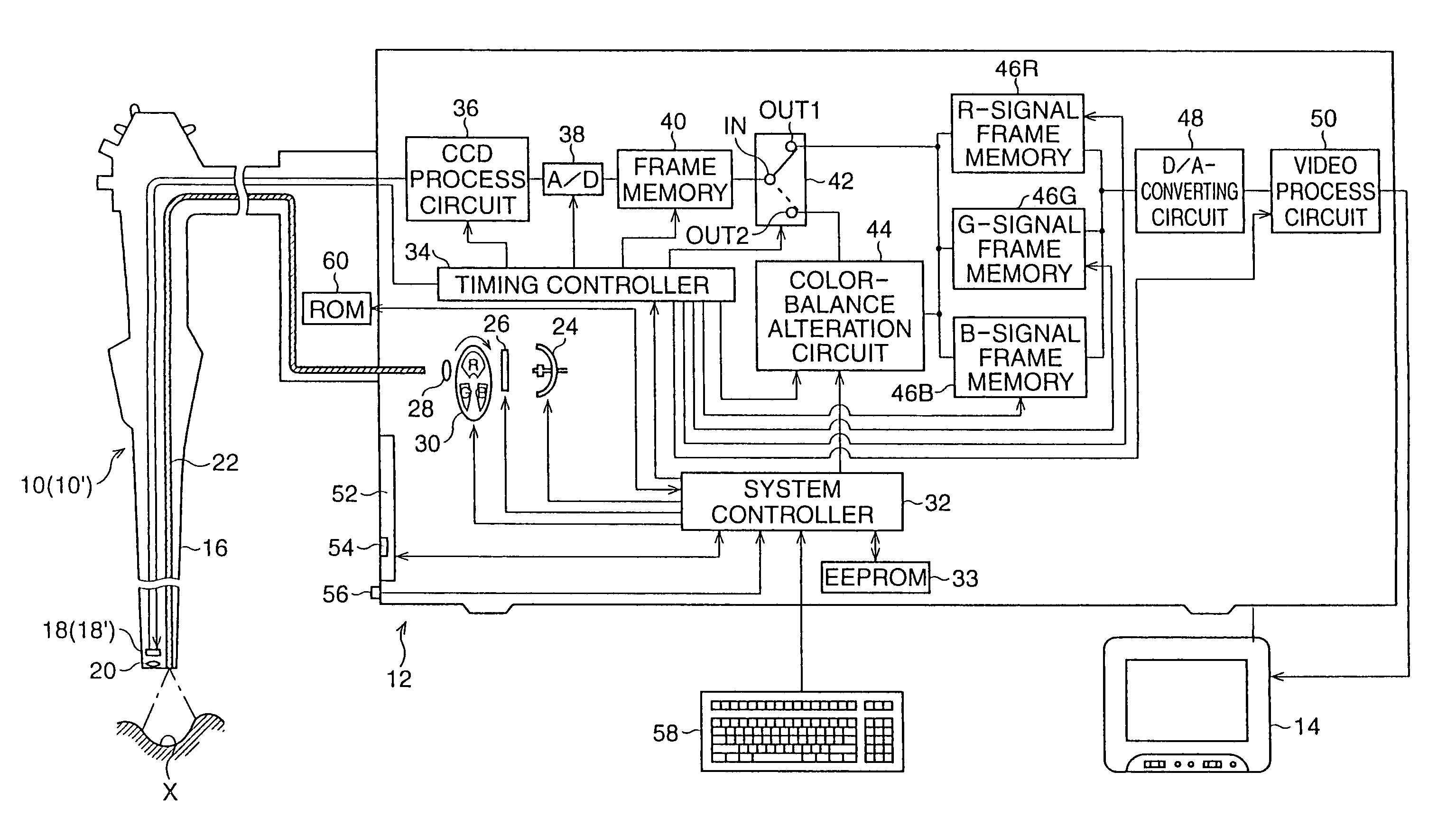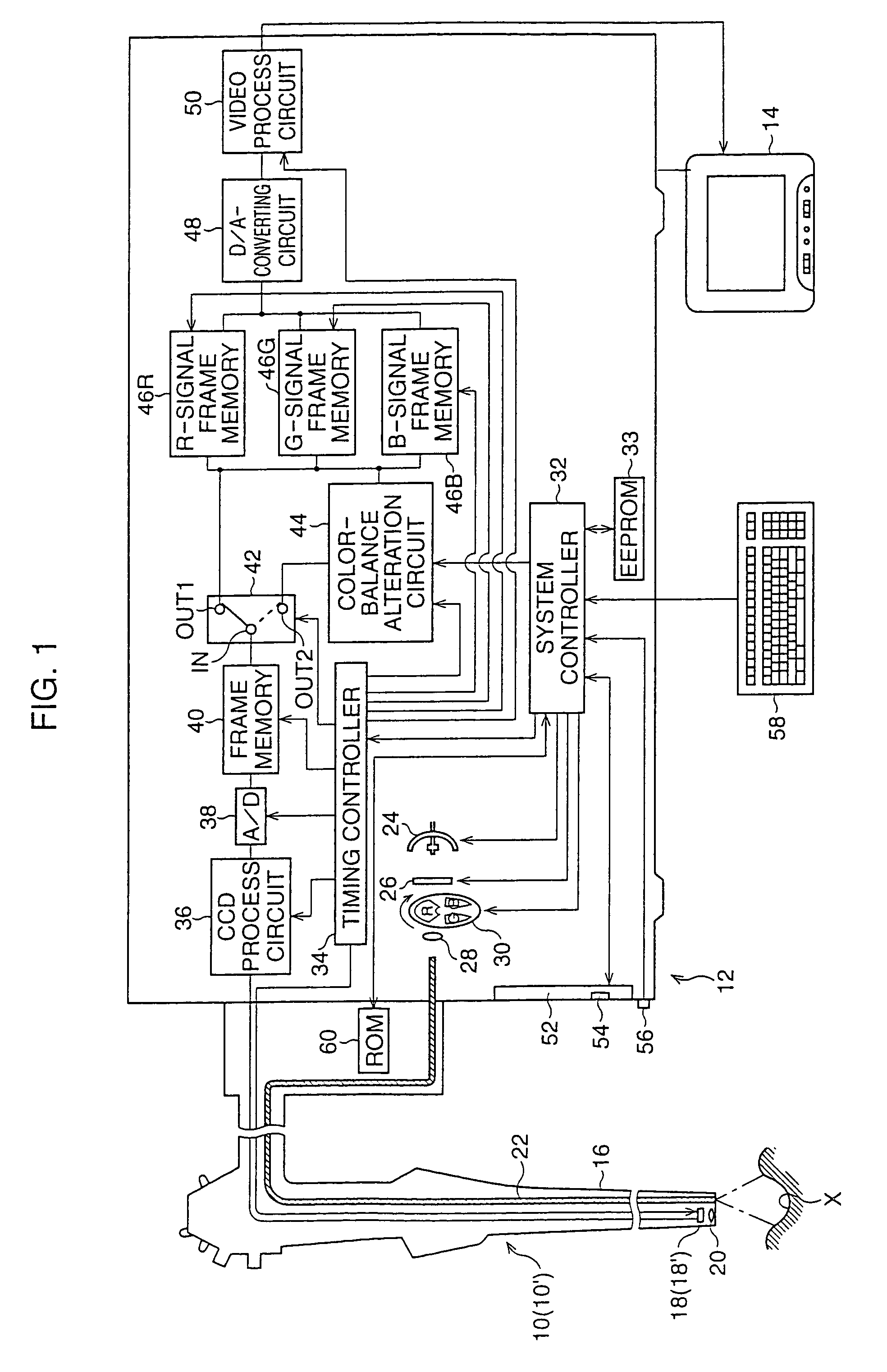Electronic endoscope system with color-balance alteration process
a color balance and endoscope technology, applied in the field of electronic endoscope systems, can solve the problems of troublesome development of harmless dyes, difficult to examine the subtle unevenness of the mucous membrane surface, dye-spraying medical examination methods,
- Summary
- Abstract
- Description
- Claims
- Application Information
AI Technical Summary
Benefits of technology
Problems solved by technology
Method used
Image
Examples
first embodiment
[0062]Referring to FIG. 1, a first embodiment of an electronic endoscope system according to the present invention is shown as a block diagram. The electronic endoscope system comprises a video scope 10, an image-signal processing unit 12 to which the video scope 10 is detachably coupled, and a TV monitor 14 to which the image-signal processing unit 12 is connected. In this embodiment, at least two video scopes 10 use the image-signal processor 12 in common. This is because the scope 10 is detachably coupled to the image-signal processing unit 12.
[0063]The video scope 10 includes a flexible conduit 16 which is provided with a solid-state image sensor 18, such as a CCD (charge-coupled-device) image sensor, at the distal end thereof, and the CCD image sensor 18 is associated with an objective lens 20. When a connection is established between the video scope 10 and the image-signal processing unit 12, the CCD image sensor 18 is electrically connected to an image-signal processor provid...
second embodiment
[0131]Referring to FIG. 8, a second embodiment of an electronic endoscope system according to the present invention is shown as a block diagram. In this drawing, the features similar to those of FIG. 1 are indicated by the same references.
[0132]In the second embodiment, an on-chip color filter method (i.e., a simultaneous imaging method) is introduced to reproduce an endoscope image as a full color image on a TV monitor 14, instead of the RGB field sequential-type color imaging method, and a video scope 10 and an image-signal processing unit 12 are modified so as to conform to the on-chip color filter method.
[0133]In particular, a CCD image sensor 18 has a complementary color filter (not shown) provided on a light-receiving surface thereof. Also, a light source device, provided in the image-signal processing unit 12, is formed by a white light lamp 24, a diaphragm 26, and a condenser lens 28. Namely, the rotary color-filter 30 is eliminated from the light source device. Thus, white ...
third embodiment
[0143]Referring to FIG. 10, a third embodiment of an electronic endoscope system according to the present invention is shown as a block diagram. As is apparent from this drawing, the third embodiment is generally identical to the first embodiment shown in FIG. 1. In FIG. 10, the features similar to those of FIG. 1 are indicated by the same references. According to the third embodiment, the electronic endoscope system is constituted such that a simulated-dye-sprayed endoscope image is displayed together with a usual full color endoscope image on a TV monitor 14 while selecting a simulated dye-spraying (SDS) display mode, but only the usual full color endoscope image is displayed on the TV monitor 14 while selecting the usual display mode, similar to the first embodiment.
[0144]As shown in FIG. 10, in the third embodiment, a frame memory circuit 46 is substituted for the R-signal, G-signal, and B-signal frame memory 46R, 46G, and 46B, and includes a first R-signal frame memory 46R1, a ...
PUM
 Login to View More
Login to View More Abstract
Description
Claims
Application Information
 Login to View More
Login to View More - R&D
- Intellectual Property
- Life Sciences
- Materials
- Tech Scout
- Unparalleled Data Quality
- Higher Quality Content
- 60% Fewer Hallucinations
Browse by: Latest US Patents, China's latest patents, Technical Efficacy Thesaurus, Application Domain, Technology Topic, Popular Technical Reports.
© 2025 PatSnap. All rights reserved.Legal|Privacy policy|Modern Slavery Act Transparency Statement|Sitemap|About US| Contact US: help@patsnap.com



